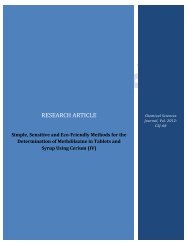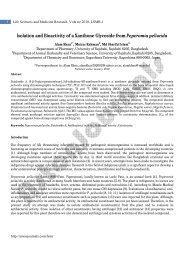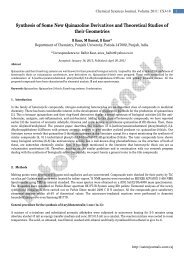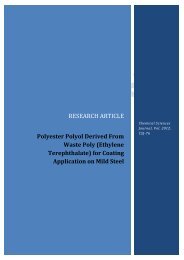Simple and Rapid Spectrophotometric ... - AstonJournals
Simple and Rapid Spectrophotometric ... - AstonJournals
Simple and Rapid Spectrophotometric ... - AstonJournals
Create successful ePaper yourself
Turn your PDF publications into a flip-book with our unique Google optimized e-Paper software.
2 Research Article<br />
Visible spectrophotometry, because of its simplicity <strong>and</strong> cost-effectiveness, sensitivity <strong>and</strong> selectivity <strong>and</strong><br />
fair accuracy <strong>and</strong> precision is routinely used in many industrial quality control laboratories. Several visible<br />
spectrophotometric methods based on different reaction schemes are found in the literature for PPH.<br />
Idowu et al. [16] reported a method for the assay of PPH using diazotized 4-amino-3,5-dinitrobenzoic acid<br />
(ADBA) as the chromogenic derivatizing reagent. Bh<strong>and</strong>ari et al. [17] reported a method based on the reaction of<br />
PPH with 1-chloro-2,4-dinitrobenzene, forming a complex, which absorb maximally at 314.6 nm. In a method<br />
reported by Golcuet al. [18], PPH was reacted with copper (II) or cobalt (II) <strong>and</strong> the colored complexes were<br />
measured at 548 or 614 nm. El-Rieset al. [19] proposed two spectrophotometric methods based on the chargetransfer<br />
complex reaction of PPH with π-acceptors, tetracyanoethylene (TCNE), or chloranilic acid (CLA) to give<br />
highly colored complex species which are quantitated spectrophotometrically at 415 or 510 nm. Salem [20] used<br />
similar reactions for the spectrophotometric determination of PPH which are based on the reaction of PPH as n-<br />
electron donor with the sigma-acceptor iodine <strong>and</strong> π-acceptors such as 7,7,8,8-tetracyaniquinodimethane, 2,3-<br />
dichloro-5,6-dicyano-1,4-benzoquinone, tetracyanoethylene, bromanil <strong>and</strong> chloranil. The resulting CT complexes<br />
were measured at 365, 840, 420, 470, 450 <strong>and</strong> 440 nm, respectively. Hussain et al. [21] reported a method based<br />
on the redox reaction of PPH with cerium (IV) in H 2 SO 4 medium on heating <strong>and</strong> the developed color was measured<br />
at 478 nm. El-Emam et al. [22] reported a method based on oxidative-coupling reaction in which a mixture of an<br />
acidic solution of MBTH <strong>and</strong> PPH was treated with cerium (IV) <strong>and</strong> the resulting orange color peaking at 496 nm<br />
was measured.<br />
In addition to direct methods described above, several indirect methods based on a variety of reaction<br />
chemistries are also found in the literature. A spectrophotometric method proposed by Basavaiah et al. [23] makes<br />
use of the reaction between chloride of PPH <strong>and</strong> mercury(II) thiocyanate in which thiocyanate ions displaced<br />
complexed with iron(III) for subsequent measurement at 460 nm. In a spectrophotometric method reported by<br />
Basavaiah et al. [24], the unreacted cerium(IV) sulphate was treated with iron(II) <strong>and</strong> the iron(III) was complexed<br />
with thiocyanate <strong>and</strong> measured at 480 nm. Similar method reported by Basavaiah et al. [25] is based on the<br />
oxidation of PPH by a known excess of CAT in acid medium followed by determination of the unreacted oxidant by<br />
reacting with metal <strong>and</strong> sulphanilic acid. The same authors reported another spectrophotometric method in which<br />
the unreacted oxidant metavanadate was determined by reacting with diphenylamine, <strong>and</strong> the absorbance<br />
measured at 560 nm [26]. A method reported by Basavaiah et al. [27] involves the addition of a known excess of<br />
bromate-bromide mixture to an acidified solution of the drug <strong>and</strong> determination of the unreacted bromine by its<br />
bleaching action on methyl orange acid color <strong>and</strong> the absorbance measured at 510 nm. El-Didamony [28] reported<br />
three methods based on oxidation-bromination reaction of PPH by bromine, generated in situ by the action of acid<br />
on a bromate-bromide mixture, followed by determination of unreacted bromine by three different reaction<br />
schemes. In one method the residual bromine was determined by indigo carmine dye. In the other two methods,<br />
the residual bromine was determined by treating with a known excess of iron(II) <strong>and</strong> the resulting iron(III) was<br />
complexed with thiocyanate or the residual iron(II) with 1,10-phenanthroline. Gowda et al. [29] reported two<br />
procedures, similar to the above, in which PPH was oxidized by a known excess of NBS in H 2 SO 4 medium followed<br />
by the reaction of unreacted oxidant with promethazine hydrochloride (PH) or methdilazine hydrochloride (MDH)<br />
to yield red colored products with absorption maximum at 515 or 513 nm. Two methods described by Al-Attas et<br />
al. [30] based on the oxidation of PPH by a known excess of N-bromosuccinimide (NBS), in an acidic medium<br />
followed by the reaction of excess oxidant with amaranth dye. Sastry et al. [31] devised one more method by<br />
treating PPH with a known excess of NBS in HCl medium, <strong>and</strong> after 10 min, the unreacted oxidant was determined<br />
by reacting with celestine blue <strong>and</strong> measuring the absorbance at 540 nm.<br />
Most of the reported spectrophotometric methods suffer from one or the other disadvantage such as use<br />
of heating/extraction step, critical dependence on pH, narrow linear range, poor sensitivity, use of multi reagents/<br />
multi step reactions, longer contact time etc. as summarized in Table 1. The methods based on C-T complexation<br />
reactions <strong>and</strong> using σ <strong>and</strong> π acceptors [19, 20] are less sensitive <strong>and</strong> have narrow linear ranges. Though substituted<br />
phenols (picric acid <strong>and</strong> dinitrophenol) have found wide applications as C-T complexing agents in the assay of<br />
pharmaceuticals [32-34], they have not applied for the assay of PPH. In this work, we demonstrate the use of picric<br />
acid <strong>and</strong> dinitrophenol as C-T complexing agents for the simple, rapid, sensitive <strong>and</strong> selective assay of PPH in<br />
pharmaceuticals. The methods are based on the formation of C-T complex of PPH base (PPL) with picric acid<br />
(method A) or dinitrophenol (method B) followed by the measurement of the absorbance of the colored species at<br />
420 nm. The methods were demonstrated to be accurate, precise, robust <strong>and</strong> rugged, <strong>and</strong> eminently suited for<br />
rapid analysis in routine work.<br />
http://astonjournals.com/csj



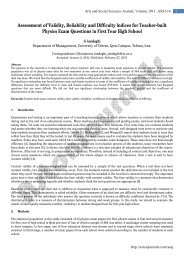
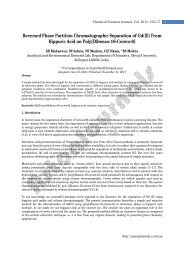
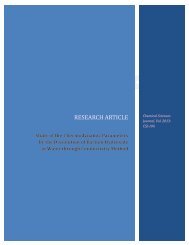
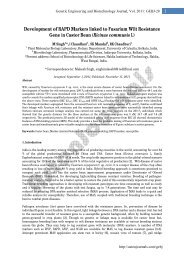

![[1,4]-benzodiazepine-2-one Derivatives as Potent - AstonJournals](https://img.yumpu.com/49117784/1/184x260/14-benzodiazepine-2-one-derivatives-as-potent-astonjournals.jpg?quality=85)

